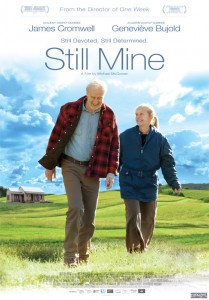It Is Not Over Yet
Posted on April 29, 2021 at 5:20 pm
B| Lowest Recommended Age: | High School |
| Profanity: | Brief strong language |
| Alcohol/ Drugs: | Prescription drugs |
| Violence/ Scariness: | Sad deaths |
| Diversity Issues: | None |
| Date Released to Theaters: | April 30, 2021 |

One image I will remember best from “It Is Not Over Yet,” a documentary about an innovative care center for people with dementia, is the place settings. They reminded me of the good work of the Little Brothers of the Poor and Elderly, who always bring a flower and a cloth napkin when they deliver meals to people in need, because they know that those they help deserve these small touches of grace to feed their spirits as well as their bodies. At the Danish home for people with memory loss called Dagmarsminde the table settings are festive and pretty, not like the utilitarian hospital-like food trays in many facilities. Founder May Bjerre Eiby tells a group that her first job was in such a facility, all drab colors and bad smells. She became a nurse, determined to do better, but as she was saving money to create Dagmarsminde her own father became a resident of the facility where she first worked. They left his meals in his room, not understanding that he could not feed himself. He died there, she says, from neglect.
No one is neglected at Dagmarsminde, where their building principle is that “compassion is medicine.” While the average number of medications for residents in assisted living is ten per day, at Dagmarsminde it is one. Instead of medication to dull their perception, or, as in the case of one new resident, medication still being prescribed long after its ability to affect the patient was exceeded, leaving only the side effects, the residents at Dagmarsminde get cake. They get attention. Most of all, they are listened to. Just because memory is fading does not mean that a person wants to feel isolated.
Like all homes for the elderly, residents die. And when they do, the staff makes an announcement, the coffin, decorated with flowers, is brought into the area where the residents gather, and they sing a song to bid their comrade farewell. Later in the movie we see the deeply compassionate “death watching,” as the staff stays near a dying woman, making sure she is reassured and comfortable.

This is a Frederic Wiseman-style documentary, observation without talking head experts or statistics. We might wonder, for example, what happens when they decide to take a new resident off of the three different morphine-based medications she is on, or how (as they say) they are able to provide this staff-intensive level of care without extra cost. It is impossible not to be touched by the devoted couple knowing they are nearing the end, satisfied that their lives were good and past caring about old hurts.
Those of us who have visited our own family in memory care facilities or struggled to care for them at home will not wonder whether this is a better, more humane, more loving way to treat people with dementia. We will wonder only whether, when our time comes, we can find a place like Dagmarsminde.
Parents should know that this film deals with aging, memory loss, and death. There is some alcohol and a reference to adultery.
Family discussion: If you could build a facility for memory loss patients, what would it be like? What can we do to make more places like Dagmarsminde available?
If you like this, try: “Young at Heart” and “I Remember Better When I Paint”





